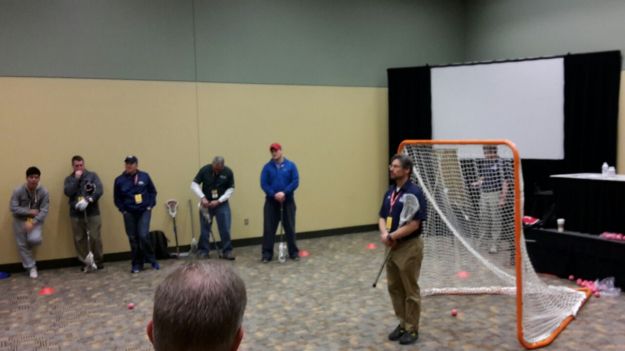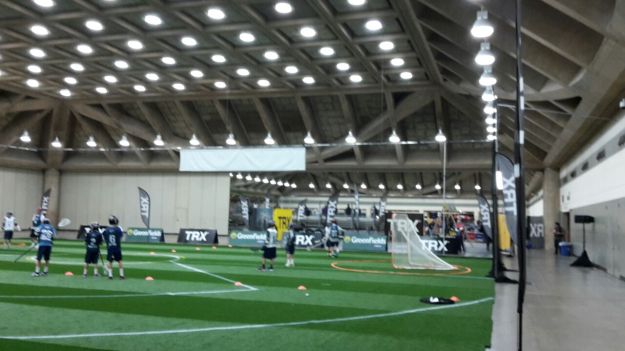In January we spent some time in the U.S. While Eric was doing sightseeing in New York City, I spent time visiting friends in Washington, D.C. and Philadelphia. But that is not what this blog article is about. The main destination of our trips was Baltimore, MD to attend the U.S. Lacrosse Convention.
We would like to thank ABV Stuttgart 1893 e.V. and Lacrosse Freunde Stuttgart, who supported our trip to the convention. We would also like to thank U.S. Lacrosse, who awarded us scholarships to attend the convention, so we saved some money on the conference fees and especially our teammate from Team Germany Chris Mattes, who was an excellent host.
To show you more than just great pictures of the lacrosse convention and all the stuff that was happening around it, we will share some interesting lessons we learned between the lines. There are tons of resources on the internet to learn about the X’s and O’s, new drills and so on. The thing that was most interesting for us were those little details the coaches mentioned in their talks or during the coaching clinic we attended where we thought: “Wow, that’s cool! It is so obvious, why haven’t I thought of that yet?” We called them lessons learnt between the lines.
Here are a few examples of those lessons between the lines:
Visual cues – kiss the stick
Use visual cues to explain and teach your players certain things. One example is kiss the stick when you do a roll dodge. At the beginning you can have your players literally kiss their sticks to practice the right execution. If you do that, you automatically protect your stick and do not leave it hanging out when you change hands. Now imagine in your mind the following instructions for a roll dodge:
- Protect your stick
- Hide your stick
- Kiss your stick
Which is the easiest one to execute?
Every transition drill should start out of a scramble – make it messy
From our experience a lot of transition like fast breaks and slow breaks are practiced out of a specific settled start. Three attackmen stand on their designated spots, either directly in their fast break spots or maybe you told them to stand higher near the midline; then one guy picks up a ball near the midline and runs down the field for a fast break. How many times does this actually happen during a game?
You could argue that you are just practicing a specific part of the fastbreak with a single focus, which is how drills are properly designed, but you still have to get the circumstances right. Before most transition opportunities you have played defense for a couple of minutes and then ran the ball 60 yards down the field, so you are most likely exhausted when you make that pass to the attackmen.
So: make transition drills messy, have them start from all kinds of places on the field, out of different kinds of situations, mimic game-like situations like GBs off the face-off wing play, take-aways from your middies at the top of the box, breakout passes from your goalie, etc.
Shooting target : milk/juice box with carabiner
It is a very easy and cheap way to put targets into the goal, but the biggest benefit is the time it takes to put it in. Have you ever hooked up a cage with a banged-up rejector? This takes ages and pretty much falls down after the third shot.
No questions on defensive communication
Who has not been in a situation, where the defense is yelling: who is hot? Every time there is no answer the question gets yelled louder and more aggressively.
A question requires an answer, which makes communication more complicated. Use direct communication and if you did not get who is hot, that probably means no one is hot at the moment. So either pick the task yourself, if you are in the proper position and say: “I am hot.” or look around to see who is in the proper position and tell him directly: “Jonny, you are hot.” If Billy thought he was hot in that case, he now adjusts to Jonny being hot. Since you did not know Billy thought he was hot, this shows where future work needs to be done. Billy needs to work on his communication.
Use communication to make up for mistakes on defense
This last lesson is directly connected to the one before. Do not worry so much about your perfectly scripted slide package, where everybody knows when to go where. We are not X’s and O’s on a whiteboard or an animated iPad app, but real players who make mistakes. In a game, things do not go the way they are shown on an iPad. The first thing that goes wrong is your opponents’ offense is screwing up their spacing and positioning, so your defense players are not in the positions they have been shown on the iPad.
Just deal with the mistakes, do not worry about them. Use direct and effective communication to make up for mistakes. Do not worry so much about whether Bobby or Jimmy was the right person to slide, just make sure your players communicate to recover as fast as possible and be set up. It is called team defense and you can make up for a lot of mistakes if you just keep playing and communicate instead of trying to figure out if the right person was sliding.
Those are just a few examples of those lessons between the lines we learnt and we would like to ask our readers to comment on them and share your little details that go beyond the X’s and O’s, but helped you in your coaching career.
To finish this blog post about the lacrosse convention we will post some more pictures. Enjoy and hopefully see you next year at the convention. We can highly recommend it for every lacrosse coach.
Impressions from the conference:






